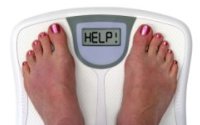How to Count Calories to Lose Weight - The Basic Blueprint

Okay, before we start with the blueprint, I want everybody to keep this in mind: it’s not “weight” you want to lose, but “fat.” Everybody calls it “weight loss,” but, believe me, you don’t want to be losing muscle in your quest for a thinner body. I’ll be using terms like weight loss and lose weight, but I really mean “fat loss” and “losing fat.”
What I’ve got for you is a 5 step “blueprint” to lose weight by counting calories, covering how many calories you should eat in a day to lose to carb/protein/fat ratios, and more.
If you grab a pen and a piece of paper to write down numbers as you read along, you’ll have a calorie counting plan by the end of it all.
1) Figure Out How Many Calories You Should Eat A Day to Lose Weight
To put it very simply, you need to create a “calorie deficit” to lose weight. What that means is, you want to eat less calories than your body burns in a day.
For example, if your body burns 2000 calories a day but you eat only 1700 calories a day, you create a calorie deficit of 300 calories a day and you’ll lose weight. If your body burns 2000 calories a day and you eat 2300 calories a day, you’re creating a calorie surplus of 300 calories, and you’ll end up gaining weight over time.
(Now, at this point some may argue about carb sensitivity, but I’m trying to keep this simple and down to the basics.)
You can create a calorie deficit by:
a) eating less calories than you do now, if you overeat;
b) exercising more;
c) a combination of (a) and (b) (usually, this is the best way because you strengthen your body at the same time).
The easiest way to figure out how many calories you should be eating to create a calorie deficit is to use the FitWatch Calorie Deficit Calculator. The calculator will take into account approximately how many calories you burn in a day and give you a few choices for a calorie deficit.
If you’re not sure which calorie deficit to choose, go for the 20% calorie deficit. It’s moderate enough to show results, but not so aggressive you’ll be gnawing on wood out of hunger. Bear in mind, the results are estimates but it should give you a good starting point.
And also keep in mind this general rule of thumb: ladies, don’t go below 1200 calories and, guys, don’t go below 1800 calories a day. Your body burns up most of its daily calories just by keeping your body alive—even while you’re asleep! It needs fuel (calories) to do this. Personally, I can’t go below 1500 or 1600 calories a day; I just get too hungry and start feeling weak.
Remember that pen and paper I told you to grab? Once you use the Calorie Deficit Calculator, write down the number of calories you’re going to eat in a day. That’s your daily calorie goal.
2) Figure Out What Proportion of Carbs, Protein and Fat You Should Eat (aka: Macronutrient Ratios)
Protein: Foods from animal sources (beef, chicken, fish, etc.), legumes (chickpeas, beans), egg whites, dairy products, soy
Fat: Oils such as olive, peanut, avocado and canola, fatty fish (like salmon), nuts
Now, you can skip this part if you want—but I recommend that you don’t. There’s more to losing weight than just creating a calorie deficit! The quality of the food is very important. What’s the point of creating a calorie deficit and then eating junk food all day? You’re just setting yourself up for failure.
If you eat the right proportions of carbs, protein and fat, you’ll not only be healthy, but you’ll curb cravings and feel less hungry.
Expert trainer Tom Venuto recommends a baseline of 50% carbs, 30% protein and 20% fat to start off with. In other words, of your total daily calories, 50% should come from carbs, 30% from protein and 20% from fat.
I find I do very well with those percentages, but I sometimes need to drop the carbs a bit more to around 45% and up the protein. So, I end up with a ratio of 45% carbs, 35% protein and 20% fat
If you exercise a lot, you *may* want to go up to 60% carbs. Also, take into considerations any health issues you may have. For example, your doctor may have recommended a low fat diet, etc.
If you’ve never counted calories before, the baseline of 50% carbs, 30% protein and 20% fat is a good way to start. You can always adjust the ratios as you go along.
So, now, on that same piece of paper, write down the ratios you’re going to be aiming for. Again, the baseline I mentioned was 50% carbs, 30% protein, 20% fat. If you’re making any adjustments, just make sure your ratios add up to 100%.
Note about alcohol: Notice how the baseline doesn’t include alcohol? 1 gram of alcohol is equal to 7 calories, so alcohol calories add up quickly—and they take away from your healthy carb, protein and fat ratios. Not only does alcohol add empty calories to your diet, it also interferes with fat loss: your liver is too busy processing alcohol and doesn’t have time to help you burn fat. If you’re serious about fat loss, keep the alcohol down to a minimum.
3) How to Track Your Calories
Okay, so you know how many calories you’re going to eat in a day and what macronutrient ratios you’ll be using. Now, it’s time to decide how you’re going to keep track of the calories. You can do it with an online tracker, an offline tracker, or use a pen/paper (or use an Excel spreadsheet, if you’re so inclined).
The absolutely easiest way is to use an online or offline calorie tracker because all the calculations are made for you. All you need to do is enter the food you eat and the quantities, and… Presto! Blammo! The tracker will add up all the calories and figure out the percentages of carbs, protein and fat (and alcohol).
Online - I recommend the FitWatch Fitness Tracker to count and keep track of your calories. (I offer a free 7 day trial, and I try to keep it affordable at only $4.95/month. There’s a also a free version if you’re on tight budget—but the free version has advertising and has less features.)
Calorie Counting Journals - I have two logs/diaries you can print out if you’re going the pen/paper route: Printable Standard Food Diary and the Printable Customized Food Diary.
Or you can buy food journals over at Amazon.com. Here are two selections:
DIETMINDER Personal Food & Fitness Journal
The Calorie King Food & Exercise Journal
You can then use the free FitWatch Calorie Counter to look up the calorie count of your favorite foods, or check out these calorie counter books.
There are also scales that will not only measure your food but give you the calorie count as well. (The
EatSmart Digital Nutrition Scale is on my wish list!)
Your online or offline software will calculate the ratios for you. A typical baseline meal consists of a serving of lean protein (chicken breast, for example), a serving of starchy carbs (let’s say, brown rice) and a generous serving of vegetables (a spinach/cucumber/red pepper/tomato salad comes to mind).
If you track each meal, you can adjust as the day goes on if you see that your ratios are off. I usually need to eat less carbs for supper and a bit more protein to reach my ratio goals. My breakfasts can sometimes have a higher percentage of carbs, so I skip the starchy carbs at suppertime and just eat meat and veggies.
To figure out how many calories per meal you should be eating, take your total daily calories from Step 1 and plug it into my Calories per Meal calculator.
Using Pen and Paper?
If you’re using the pen/paper method, write down the calories, carb grams, protein grams and fat grams for each food item. Add it all up and then get an estimate of your ratios using these formulas:
Carbs: (carb grams X 4) / total calories = % of carbs e.g: (208g multiplied by 4) divided by 1600 = 52% carbs
Protein: (protein grams X 4) / total calories = % of protein e.g: (109g multiplied by 4) divided by 1600 = 27% protein
Fat: (fat grams X 9) / total calories = % of fat e.g: (31g multiplied by 9) divided by 1600 = 17%
Alcohol: (alcohol grams X 7) / total calories = % of alcohol e.g: (10g multiplied by 7) divided by 1600 = 4%
So now, write down what method you’re going to use for counting calories. If you’re not sure, write down the ones that seem most appealing. Sign up for, buy/download or print out whatever you need.
4) Start Tracking Your Food Intake
If you’ve never counted calories before, your first week is going to be a really eye-opening experience! A lot of people don’t realize how much they overeat. So, get out the measuring cups and spoons, get yourself a food scale, read labels, measure out portion sizes, and hold on to your hat, because you’re going to be in for a big surprise!
Now, I don’t want to hear any whining about how much work it is. Counting calories can be a lot of work—at first! But, you know what? I bet you eat a lot of the same things over and over again, right? Most of us are creatures of habit. And, after awhile, you’ll be able to eyeball portions, you’ll know what a serving size is of your favorite foods—it’ll become second nature.
If you’re feeling overwhelmed, just keep track of the food you normally eat in a week, without trying to make any adjustments. Get an idea of how many calories you’re eating in a day and ratios of carbs, protein and fat. After you get the hang of it, you can start making changes to the foods you eat, the portion sizes or both.
5) Track your Progress and Make Changes
Now, if your calorie tracker is worth its weight in gold, it’ll show you how many calories you’re eating in a day and how many calories you’re burning in a day. You’ll want to be eating less than you’re burning—but again, keep in mind, these are all estimates! If at any time, you feel hungry or weak, then the calculations may be off and you need to eat. Please, please, please listen to your body.
If you’re feeling hungry, bump up the calories by 100 calories and/or make sure you’re eating enough fat and protein (as well as fiber). Fat and protein take longer to digest, so you feel full longer. Fiber is also a good “filler-upper”.
After a week take your measurements (check out my How to Set A Weight Loss Goal article for tips on tracking your progress). If you’re seeing progress and you feel good, great! Stick with what you’re doing!
If you’re not seeing any progress, make sure you’re being honest about your food intake—buckle down and make sure you count everything. You can also look into adding in more exercise or, if you already exercise a lot, you can up the intensity or frequency of your exercise.
So, that’s basically how I count my calories. Just lather, rinse and repeat each day and make changes as you go along. Sure, there are different ways you can tweak your weight loss, but this is calorie counting at its most basic.
On that piece of paper, you should now have a total daily calorie goal, your ratios of carb, protein and fat, plus your chosen way to track your calories. No excuses now. Get to it!
